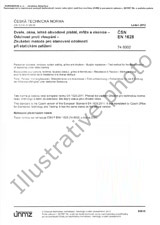We need your consent to use the individual data so that you can see information about your interests, among other things. Click "OK" to give your consent.
ČSN ETSI EN 303979-V2.1.2 (876054)
Satellite Earth Stations and Systems (SES); Harmonised Standard for Earth Stations on Mobile Platforms (ESOMP) transmitting towards satellites in non-geostationary orbit, operating in the 27,5 GHz to 29,1 GHz and 29,5 GHz to 30,0 GHz frequency bands covering the essential requirements of article 3.2 of the Directive 2014/53/EU
Translate name
STANDARD published on 1.5.2017
The information about the standard:
Designation standards: ČSN ETSI EN 303979-V2.1.2
Classification mark: 876054
Catalog number: 501560
Publication date standards: 1.5.2017
SKU: NS-681938
The number of pages: 72
Approximate weight : 216 g (0.48 lbs)
Country: Czech technical standard
Category: Technical standards ČSN
The category - similar standards:
Radio relay and fixed satellite communications systemsSatellite
Annotation of standard text ČSN ETSI EN 303979-V2.1.2 (876054):
V2.1.2
The present document applies to Earth Stations on Mobile Platforms (ESOMP), which have the following characteristics.
- The ESOMP is designed for both mobile and stationary operation.
- The ESOMP operates on various mobile platforms such as trains, maritime vessels, aircraft and other vehicles and, therefore, may be subject to occasional disturbances and interruptions in the satellite link.
- The ESOMP is operating as part of a satellite network (e.g. star, mesh or point to point) used for the distribution and/or exchange of information.
- The ESOMP is comprised of all the equipment, electrical and mechanical, from the antenna itself to the interface with other communications equipment on a mobile platform (usually referred to as the terrestrial interface).
- The ESOMP comprises of one or more emitters and the system overview given in figure 1 should be interpreted accordingly.
- The ESOMP transmits within the frequency range from 27,5 GHz to 29,1 GHz and 29,5 GHz to 30,0 GHz, which is a band allocated to the Fixed Satellite Services (FSS) (Earth to space) among other services. National regulations will specify the bands available for the operation of the ESOMP. Such regulations may designate some parts of the frequency range 27,5 GHz to 29,1 GHz to terrestrial services such as the Fixed Service. However, the operation of the ESOMP may be permitted under national regulations in the 29,50 GHz to 30,00 GHz band since this band is allocated on a primary basis to the Fixed Satellite Service.
- The ESOMP receives in one or more frequencies within the range from 17,30 GHz to 20,20 GHz (FSS).
- The ESOMP uses linear or circular polarization.
- The ESOMP operates through non-geostationary satellites.
- The ESOMP is designed for unattended operation.
- The ESOMP is controlled and monitored by a Network Control Facility (NCF). This function may be performed centrally (e.g. for a network of ESOMPs with a central hub) or it could be performed within the ESOMP for autonomous control. The NCF is outside the scope of the present document.
- The ESOMP operating in the 27,5 GHz to 28,6 GHz and 29,5 GHz to 30 GHz bands: epfd limits given in article 22 of the ITU Radio Regulations [i.4] apply for the ESOMPs operating with the NGSO system for the protection of the GSO networks (see No 22.5D of the ITU RR [i.4]).
- ESOMP operating in the 28,6 GHz to 29,1 GHz band: No 9.11A of the ITU RR [i.4] applies to the NGSO network of the ESOMP, meaning that the NGSO will be required to coordinate with earlier filed GSO networks or NGSO systems (See No. 5.523A of the ITU RR [i.4]).
The present document applies to the ESOMP with its ancillary equipment and its various telecommunication ports, and when operated within the boundary limits of the operational environmental profile as declared by the applicant and when installed as required by the applicant´s declaration or in the user documentation.
The present document is intended to cover the provisions of Directive 2014/53/EU [i.6] (RE Directive) article 3.2, which states that ". radio equipment shall be so constructed that it both effectively uses and supports the efficient use of radio spectrum in order to avoid harmful interference".
NOTE 1: Operational requirements are defined by national administrations and by relevant ECC Decisions.
In addition to the present document, other ENs that specify technical requirements in respect of essential requirements under other parts of article 3 of the Directive 2014/53/EU [i.6] may apply to equipment within the scope of the present document.
NOTE 2: A list of such ENs is included on the web site
Preview of the standard ČSN ETSI EN 303979-V2.1.2 (876054)
We recommend:
Technical standards updating
Do you want to make sure you use only the valid technical standards?
We can offer you a solution which will provide you a monthly overview concerning the updating of standards which you use.
Would you like to know more? Look at this page.




 Cookies
Cookies
